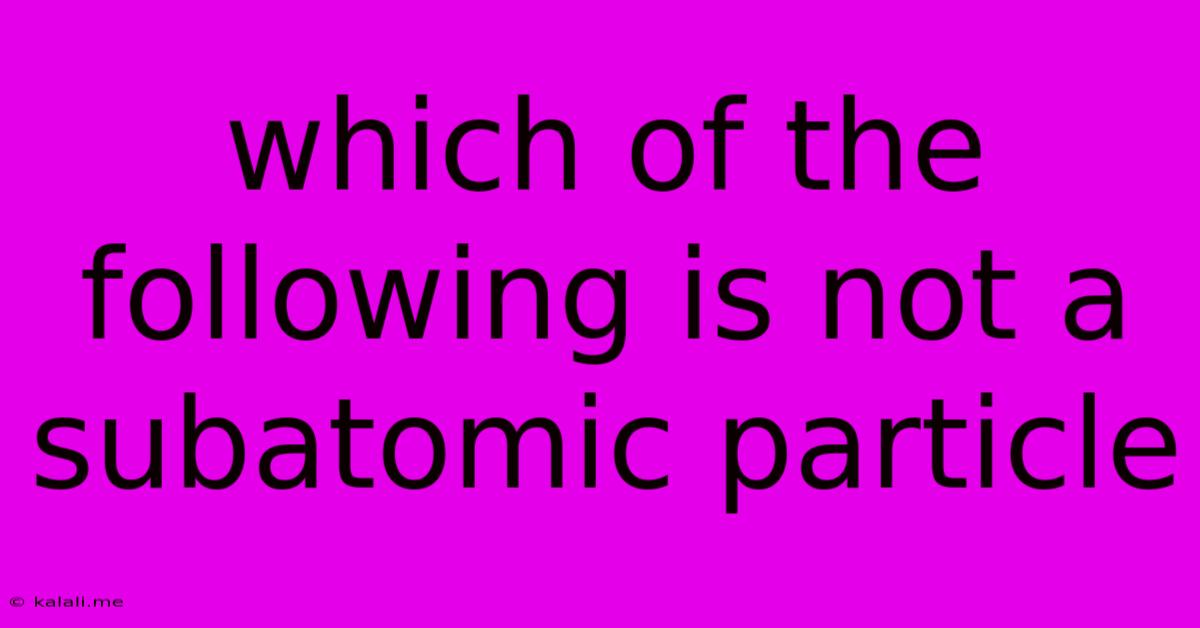Which Of The Following Is Not A Subatomic Particle
Kalali
Jun 13, 2025 · 3 min read

Table of Contents
Which of the Following is Not a Subatomic Particle? Understanding the Building Blocks of Matter
This article explores the fundamental components of matter and clarifies which of several options isn't classified as a subatomic particle. Understanding subatomic particles is crucial for comprehending the nature of atoms and the universe itself. We'll delve into the world of protons, neutrons, electrons, and other candidates, ultimately identifying the outlier.
What are Subatomic Particles?
Subatomic particles are particles smaller than an atom. Atoms, the basic building blocks of chemistry, are composed of even smaller constituents. These subatomic particles govern the properties and behavior of matter at its most fundamental level. The three primary subatomic particles found in atoms are:
- Protons: Positively charged particles located within the atom's nucleus. The number of protons determines the element's atomic number.
- Neutrons: Neutral particles (no charge) also residing in the atom's nucleus. They contribute to the atom's mass.
- Electrons: Negatively charged particles orbiting the nucleus. They participate in chemical bonding and determine an atom's chemical properties.
Beyond these fundamental constituents, the field of particle physics reveals a much more complex world. Many other subatomic particles exist, including quarks, leptons, bosons, and more, each playing a role in the intricate workings of the universe.
Identifying the Non-Subatomic Particle:
Let's consider a few examples to determine which one isn't a subatomic particle. A typical question might present a list including protons, neutrons, electrons, and perhaps a molecule or an atom. The answer would always be the molecule or the atom because these are composed of subatomic particles, not subatomic themselves.
For instance, a water molecule (H₂O) is made up of two hydrogen atoms and one oxygen atom. Each atom, in turn, is made of protons, neutrons, and electrons. Therefore, the molecule is a larger structure built from subatomic components. Similarly, an atom itself isn't a subatomic particle; it's a collection of them.
Other Potential Candidates and Clarifications:
Sometimes, the question might include less common subatomic particles. However, the underlying principle remains the same. Any particle that is itself composed of other fundamental particles wouldn't be considered a subatomic particle in the strictest sense. This distinction is important in the field of particle physics, where the exploration of increasingly smaller and more fundamental building blocks continues.
Therefore, while many particles exist at the subatomic level, the key to identifying a non-subatomic particle lies in understanding whether it is a fundamental constituent or a composite structure built from more fundamental particles. Anything that can be broken down into smaller, more fundamental particles is not a subatomic particle itself.
In Summary:
To reiterate, atoms and molecules are not subatomic particles; they are collections of them. Understanding this distinction is crucial for grasping the fundamental structure of matter and the fascinating world of particle physics. The next time you encounter a question asking which of the following is not a subatomic particle, remember to look for the larger, composite structures rather than the fundamental building blocks.
Latest Posts
Latest Posts
-
Which Of These Is Not A Step In Aerobic Respiration
Jun 13, 2025
-
Average Gpa For East Carolina University
Jun 13, 2025
-
Which Of The Following Statements Is True Regarding Emotional Intelligence
Jun 13, 2025
-
78 Square Meters To Square Feet
Jun 13, 2025
-
Youngest Mountain Range In The World
Jun 13, 2025
Related Post
Thank you for visiting our website which covers about Which Of The Following Is Not A Subatomic Particle . We hope the information provided has been useful to you. Feel free to contact us if you have any questions or need further assistance. See you next time and don't miss to bookmark.